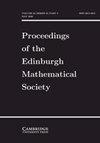The Schwarzian norm estimates for Janowski convex functions
IF 0.7
3区 数学
Q2 MATHEMATICS
Proceedings of the Edinburgh Mathematical Society
Pub Date : 2024-02-12
DOI:10.1017/s0013091524000014
引用次数: 0
Abstract
For扬诺夫斯基凸函数的施瓦兹规范估计值
对于$-1/leq B \lt A\leq 1$,让$\mathcal{C}(A,B)$表示定义在单位盘$\mathbb{D}:=\{z\in\mathbb{C}:|z|\lt 1\}$中满足从属关系$1+zf''(z)/f'(z)\prec (1+Az)/(1+Bz)$ 的归一化扬诺夫斯基凸函数类。在本文中,我们确定了类$\mathcal{C}(A,B)$ 中函数的施瓦兹规范的尖锐估计值。Dieudonné Lemma 给出了有界函数在某一点上导数的精确可变区域,它在本研究中发挥了关键作用。
本文章由计算机程序翻译,如有差异,请以英文原文为准。
求助全文
约1分钟内获得全文
求助全文
来源期刊
CiteScore
1.10
自引率
0.00%
发文量
49
审稿时长
6 months
期刊介绍:
The Edinburgh Mathematical Society was founded in 1883 and over the years, has evolved into the principal society for the promotion of mathematics research in Scotland. The Society has published its Proceedings since 1884. This journal contains research papers on topics in a broad range of pure and applied mathematics, together with a number of topical book reviews.

 求助内容:
求助内容: 应助结果提醒方式:
应助结果提醒方式:


